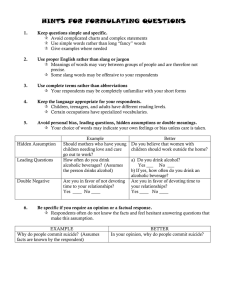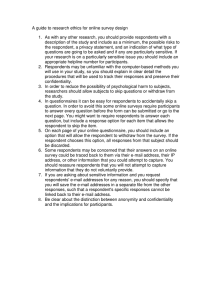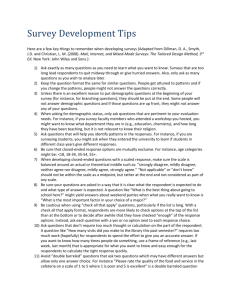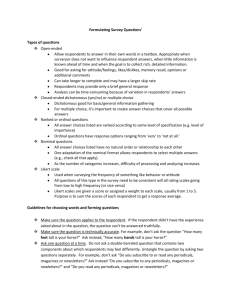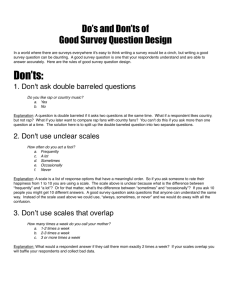PE 561: MOTIVATION IN SPORT & RECREATION
advertisement
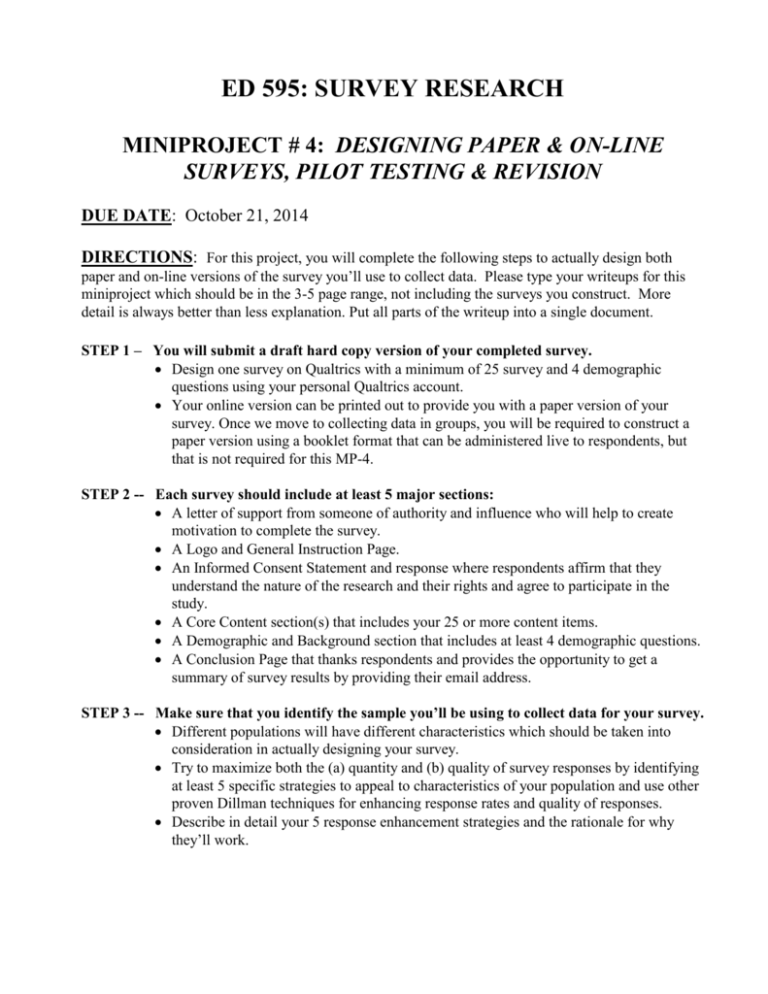
ED 595: SURVEY RESEARCH MINIPROJECT # 4: DESIGNING PAPER & ON-LINE SURVEYS, PILOT TESTING & REVISION DUE DATE: October 21, 2014 DIRECTIONS: For this project, you will complete the following steps to actually design both paper and on-line versions of the survey you’ll use to collect data. Please type your writeups for this miniproject which should be in the 3-5 page range, not including the surveys you construct. More detail is always better than less explanation. Put all parts of the writeup into a single document. STEP 1 – You will submit a draft hard copy version of your completed survey. Design one survey on Qualtrics with a minimum of 25 survey and 4 demographic questions using your personal Qualtrics account. Your online version can be printed out to provide you with a paper version of your survey. Once we move to collecting data in groups, you will be required to construct a paper version using a booklet format that can be administered live to respondents, but that is not required for this MP-4. STEP 2 -- Each survey should include at least 5 major sections: A letter of support from someone of authority and influence who will help to create motivation to complete the survey. A Logo and General Instruction Page. An Informed Consent Statement and response where respondents affirm that they understand the nature of the research and their rights and agree to participate in the study. A Core Content section(s) that includes your 25 or more content items. A Demographic and Background section that includes at least 4 demographic questions. A Conclusion Page that thanks respondents and provides the opportunity to get a summary of survey results by providing their email address. STEP 3 -- Make sure that you identify the sample you’ll be using to collect data for your survey. Different populations will have different characteristics which should be taken into consideration in actually designing your survey. Try to maximize both the (a) quantity and (b) quality of survey responses by identifying at least 5 specific strategies to appeal to characteristics of your population and use other proven Dillman techniques for enhancing response rates and quality of responses. Describe in detail your 5 response enhancement strategies and the rationale for why they’ll work. STEP 4 -- Identify at least 2-3 “categories or dimensions” of survey design that you believe will attract respondents to completing your survey and help to encourage them to respond honestly and thoughtfully. For example, (a) How will you group items? (b) What type of color scheme will you employ? (c) How will you sequence different parts of your survey? (d) How will you sequence questions within each section? (e) What should questions look like to be most appealing? Describe how each is important to your survey. STEP 5 -- Construct a survey that uses various design strategies to attract respondents to the survey and encourages them to respond thoughtfully. Describe how at least 7 specific “design strategies” were incorporated into your survey. FOR EXAMPLE . . . What type of headings will you use and what will they say? How do you make the survey interesting and inviting to the respondent? How will you sequence different parts of your survey and questions within each section to enhance appeal and a desire to respond? What design strategies will make questions look most appealing? If you are using Likert scale items, how many response options will you use and what are the descriptors for each? How many items do you include per page? How much redundancy is good in a survey such as identifying descriptors? Do your items look short, simple and easy to understand? STEP 6 -- Get at least 2 colleagues who would be familiar with the topic of your survey to rate your overall survey design and provide comments on why they rated each survey design feature the way they did. Give these reviewers (a) the survey topic, (b) the population, including age and background, who’ll be surveyed, and (c) a 5-point rating scale to assess the quality of the survey design from “very poor” to “very good” (i.e., 1 = very poor, 2 = poor, 3 = average, 4 = good, and 5 = very good) for these 8 design features. ability to attract respondent to completing the survey, general appeal of survey design for the respondent, logical sequencing of survey, ease of response, quality of instructions, reasonable completion time, ability to generate thoughtful responses, and space to comment on positive or negative aspects of each question. STEP 7 -- How can you insure your survey works? Get feedback on strengths and weaknesses. Have those 2 colleagues from Step 6 give you specific feedback on perceived strengths and weaknesses. Solicit feedback on how you can further enhance your survey design. Get feedback on how survey design will influence reliability and validity of results?

